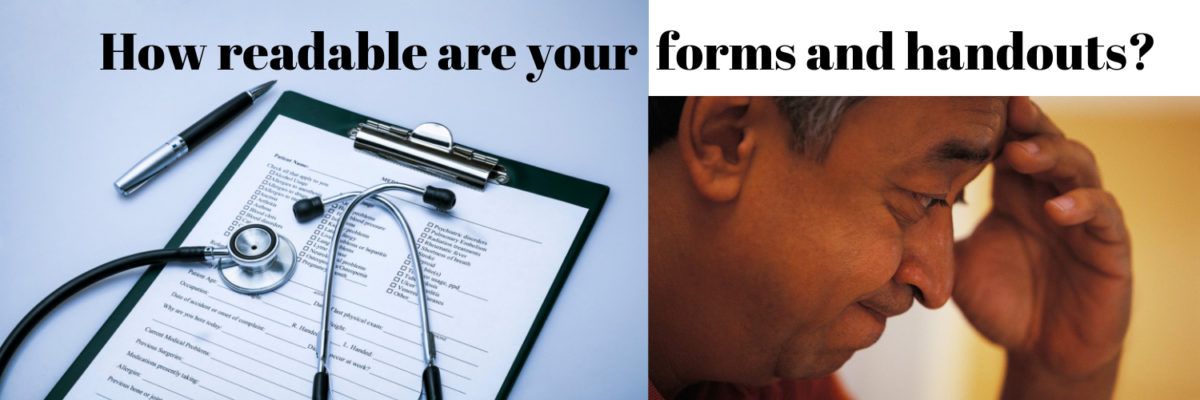How many of you give people a form or handout … or two or three … about their health and the conditions they need to manage? I’d say all of you! Forms are a necessary part of many of our days and handouts provide an easy way to share information, reinforce what we have been talking about and extend the knowledge of a person about their healthcare. They also save us busy health professionals time.
So, we’ve established we use these resources … now … how many of you check the readability of the forms and handouts you give out? I’m pretty sure the numbers just dropped significantly! If you want to make sure your form is collecting the information you want and a handout will do its job, make sure you read it to evaluate the content and readability. You can also go another step and do a formal evaluation of the readability using a calculation that scores the readability of the handout (or any other written information you put together), which can be found here.
A person’s reading literacy isn’t the only kind of literacy you need to consider when giving out printed handouts. How much capacity does the person have to put the information into action? To read the information is the first step. Obviously reading ability is important here … but so is motivation. Now I come to think about it … reading the information isn’t the first step … the first step is to want to read it! You can increase a person’s motivation to read the information by choosing information that links directly with the person’s needs and fighting the inclination to give them too much information. It’s better to focus on a specific issue, explain why you are giving them the information and how it is likely to help them. Encourage the person to write down any questions they have when reading it through. Make sure you follow-up with the person within a time frame that ensures they haven’t forgotten what they have read and extend the focus by asking how they will put the information into action. What I am talking about here is a person’s health literacy.
Over 60% of Australians have low individual health literacy.
That’s astounding isn’t it? If we don’t change the way we enable people to act on the information they are being given, the health of the nation will not achieve the positive outcomes we know are possible from all of the reported evidence around healthcare. We really aren’t spending enough time showing people how to put our advice into action and consequently there is a lot of lip-service being paid to the issue. We health professionals find it so much easier to blame ‘patients’ for not doing what we’ tell’ them to do. Arrogance I have to say is the word that comes to mind when I say this. How arrogant we are when we don’t first look at the role we have played in a person’s so-called ‘non-compliance’ at putting the changes, or to take the treatments, we ask them to do or give to them.
Health Literacy: Taking Action to improve safety and quality has been produced by the Australian Commission on Safety and Quality in Health Care and details how we can increase health literacy in Australia.
Here’s my Top 5 on how health professionals can improve health literacy in Australia:
1. Accept we have a problem and it is not okay that over 60% of Australians can’t access, understand, appraise and apply health related information and services and that we health professionals ALL have a role in changing that around.
2. Have a look at the handouts you routinely give to people and review the following:
- Is the information presented in an inviting manner?
- What is the readability like? Ask people for some feedback who have read it and consider formally assessing readability.
- Does it reinforce the information or words you use about the topic?Does it provide good advice on putting the information into action?
- Is the advice easy to follow?
3. When you go to give people handouts, ask if they are interested in reading them and provide an overview of the information covered in them. This will provide an opportunity for the person to tell you if they can’t read English – something you are best to also assess, being an important part of the health literacy skillset! Do document too that you have assessed their ability to read as it could be an important piece of information of there is ever a need for you to appear before a legal process like the Coroner’s Court.
4. Document the name of the handout/s you have provided to a person and add a reminder to ask them about the information and how it has assisted them to understand their health further at their next appointment. You could send a SMS reminder that they said they would read the information before your next appointment and that you are looking forward to talking about it with them.
5. People with diabetes either need very high health literacy or the support of someone who can help them to develop it if they are to be able to put the information we give them into action. Set them up for success by referring them to a Credentialled Diabetes Educator who will work with each individual to get to know their version of diabetes and the actions required to positively manage it for better health.
Want to find more information and resources to help you improve the health literacy of the people you work with in your work as a health professional? Read more.


